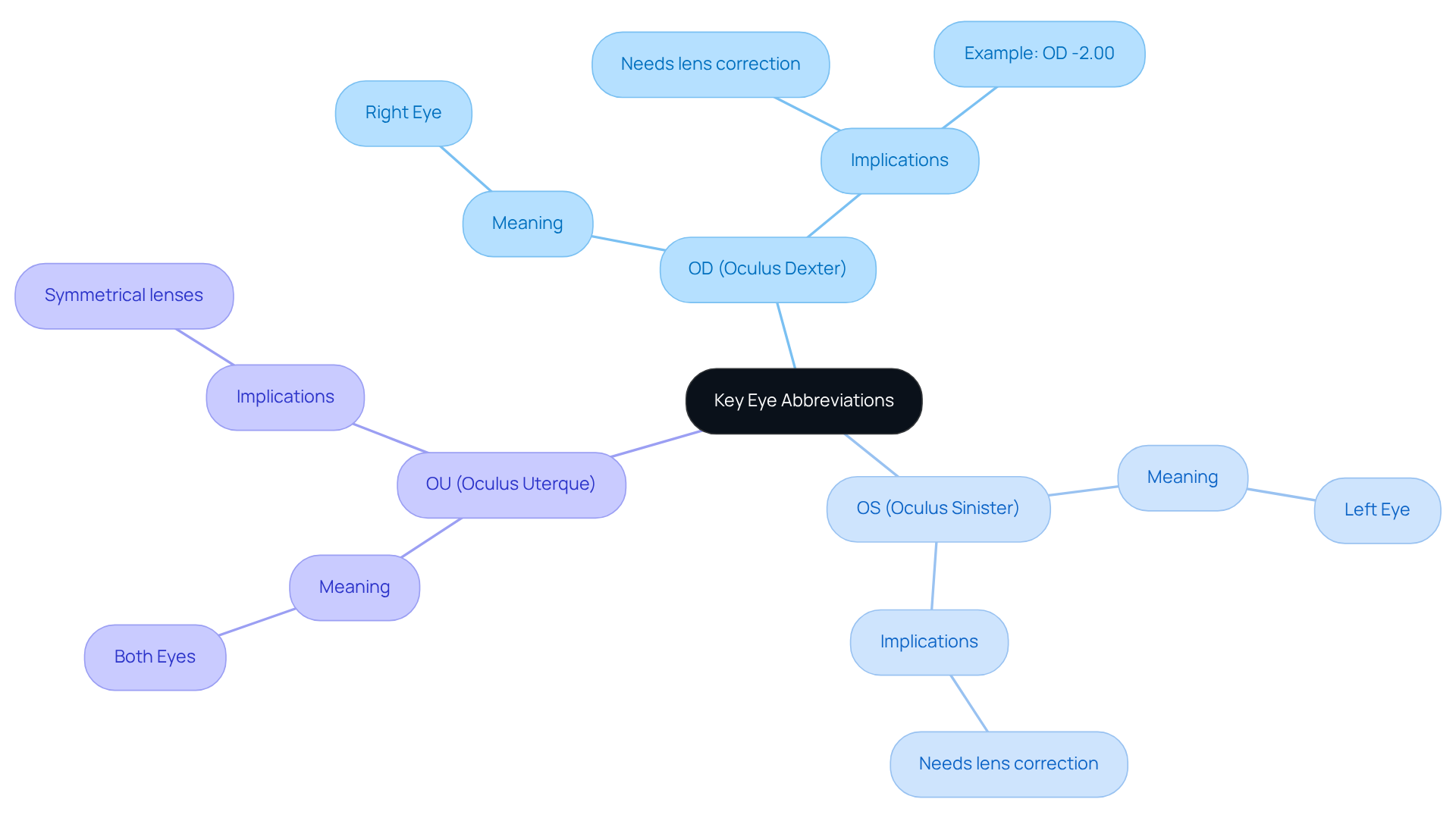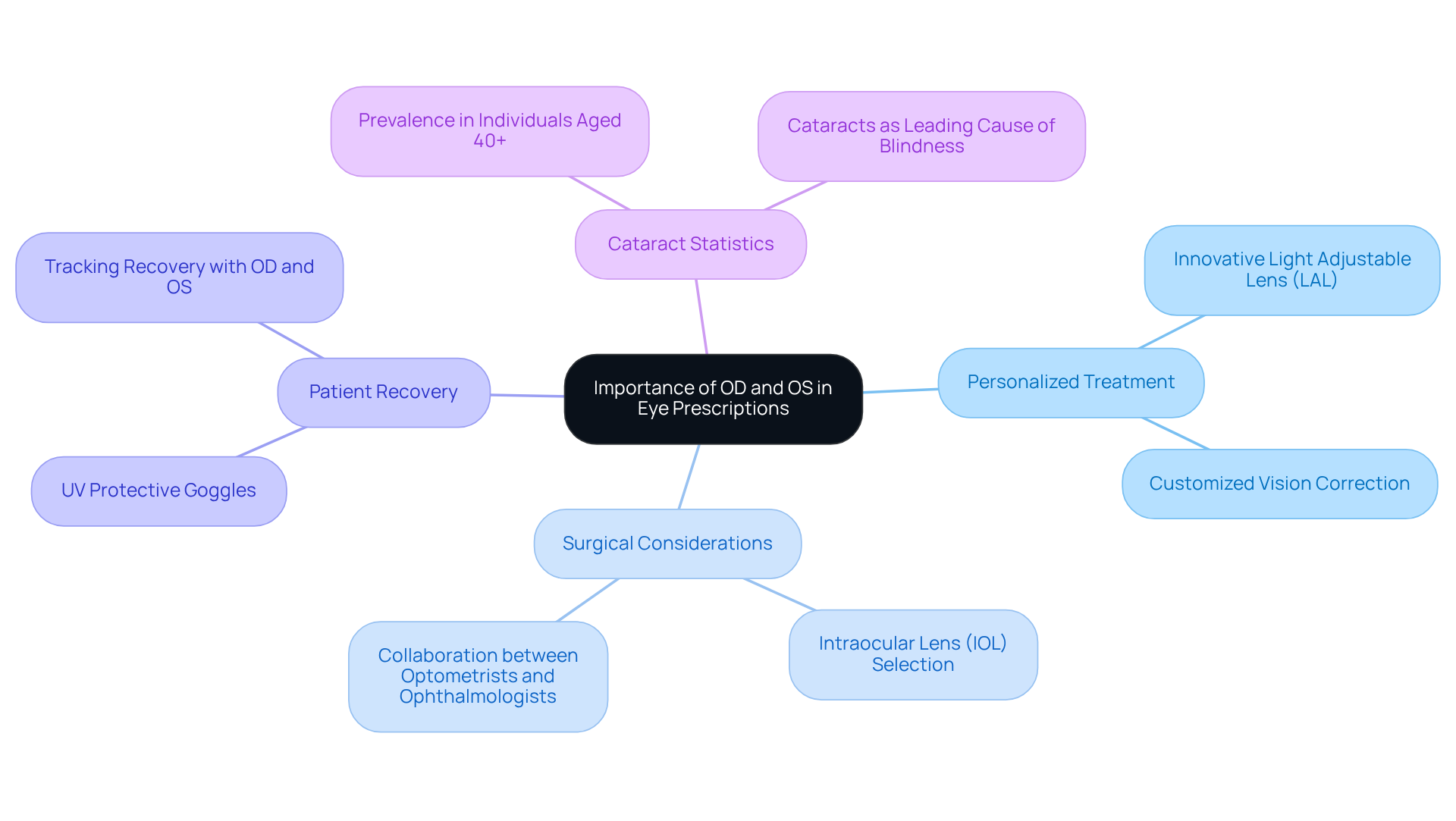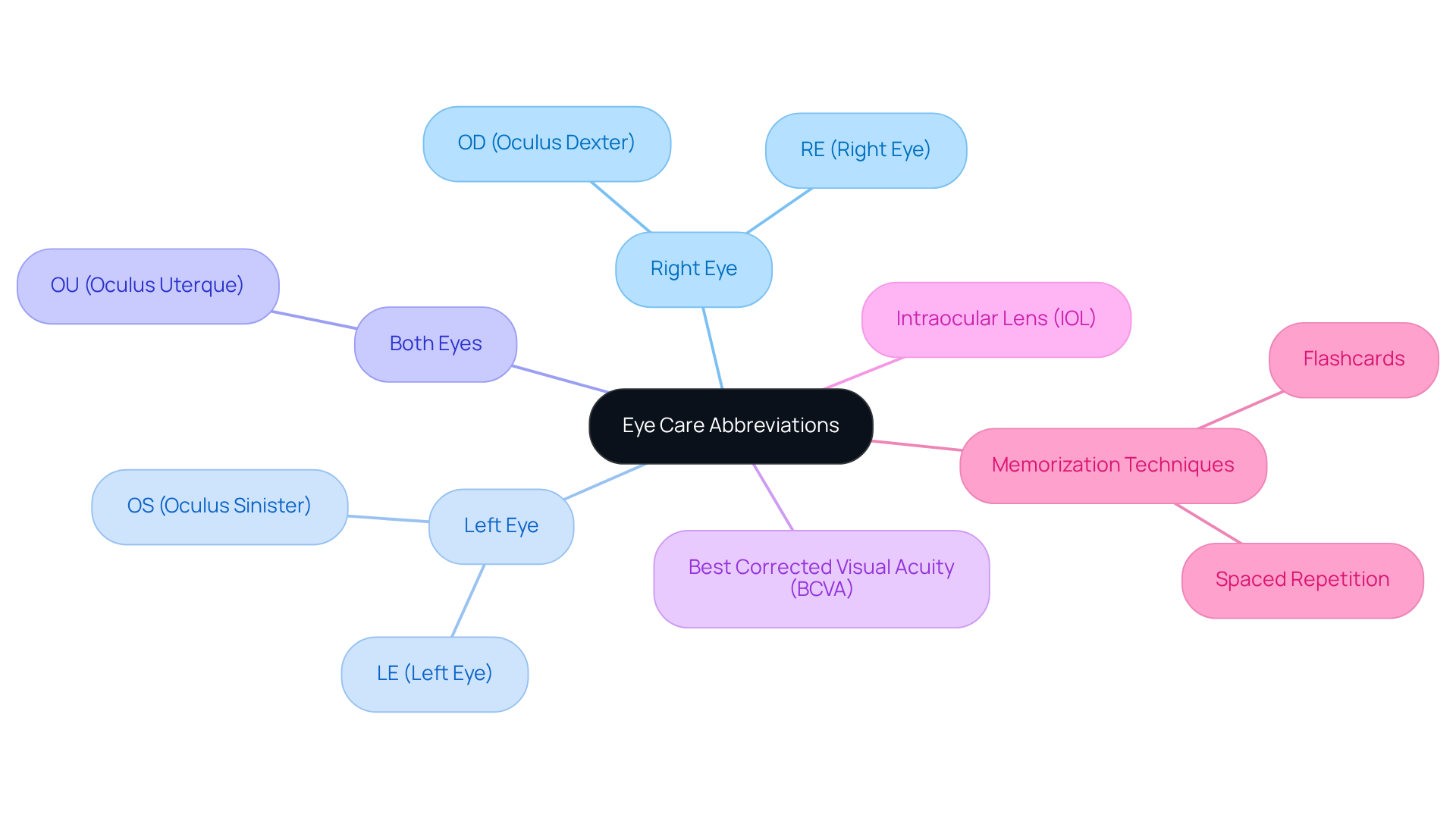Posted by: Northwest Eye in Cataract Surgery, Cataracts, General, Vision Correction on October 17, 2025
Overview
This article highlights the significance of understanding the abbreviations OD (Oculus Dexter) and OS (Oculus Sinister) for cataract patients. We understand that navigating eye prescriptions and treatment plans can feel overwhelming. By clarifying these terms, we aim to support your journey, as a better grasp of eye abbreviations can lead to improved communication with healthcare providers. This, in turn, can enhance treatment outcomes for individuals facing cataracts. Remember, you are not alone in this process; we are here to help you through it.
Introduction
Navigating the nuances of medical terminology can feel like wandering through a labyrinth, especially for cataract patients. Understanding specific abbreviations such as OD and OS is essential, as these terms represent the right and left eyes, respectively. They are not merely jargon; they are vital for effective communication with your healthcare providers and can significantly influence your treatment outcomes.
It’s common to feel overwhelmed when trying to grasp their meanings, leading to confusion and uncertainty in your care journey. However, a clearer understanding of these abbreviations can empower you and enhance your overall eye health experience.
Define Key Eye Abbreviations: OD and OS
In ophthalmology, we understand that navigating medical terms can be overwhelming. The abbreviations OD and OS come from Latin, with OD representing ‘Oculus Dexter,’ which is the right eye abbreviation meaning ‘right eye,’ and OS denoting ‘Oculus Sinister,’ referring to ‘left eye.’ These terms are crucial in eye evaluations, as they help indicate which eye may need correction or treatment.
For individuals dealing with cataracts, grasping these abbreviations is essential. It allows for a better understanding of medications and fosters smoother interactions with eye care professionals. For example, a prescription reading OD -2.00 signifies that the right eye abbreviation indicates the right eye needs a lens with a power of -2.00 diopters for optimal vision correction.
However, research indicates that many individuals find these abbreviations challenging to comprehend, which can lead to uncertainty regarding their treatment plans. We want to emphasize that a can significantly influence treatment outcomes. This clarity ensures that you receive the right support tailored to your unique needs.
Comprehending these terms not only empowers you but also enhances collaboration with healthcare experts. Together, we can work towards improving the overall quality of your eye treatment, ensuring that you feel confident and supported throughout your journey.

Explain the Importance of OD and OS in Eye Prescriptions
The significance of OD (oculus dexter), OS (oculus sinister), and the right eye abbreviation in eye measurements is crucial, particularly for individuals facing the challenges of cataracts. We understand that navigating these concerns can be overwhelming. These abbreviations enable eye care professionals to create personalized treatment plans tailored to your unique needs.
For instance, if there are differences in the measurements of each eye, it’s essential for the surgeon to consider these inconsistencies when determining the best surgical method and selecting the appropriate intraocular lens (IOL). At Northwest Eye, we offer advanced options like the Innovative Light Adjustable Lens (LAL) package, which allows for customized vision correction after cataract surgery. This lens can be fine-tuned post-operatively, typically requiring between 2 and 5 adjustments to optimize your vision for both distance and near sight, ensuring that the distinct needs of each eye are met.
We know how important it is for you to feel secure during recovery. Patients are advised to wear UV protective goggles during all waking hours for up to 6 weeks until your vision is finalized. Accurate documentation of OD and OS, including the right eye abbreviation, is also essential for tracking your recovery and managing any complications that may arise, ultimately ensuring the best possible visual outcomes.
With cataracts being the leading cause of blindness worldwide, understanding these differences can significantly influence and your satisfaction. Statistics show that around 11.8% to 18.8% of people aged 40 and above are impacted by cataracts, highlighting the importance of precise eye measurements in this group. Moreover, cooperation between optometrists and ophthalmologists is vital in managing individuals with cataracts, as it enhances the overall quality of service.
By prioritizing the precision of OD and OS in our recommendations, we are here to help you through this process, enhancing your experience and results.

Identify Additional Abbreviations and Their Meanings in Eye Care
In addition to the right eye abbreviation, which is OD (Oculus Dexter), and OS (Oculus Sinister) for the left eye, there are several other abbreviations that you may encounter in eye care. For instance, OU stands for ‘Oculus Uterque,’ meaning ‘both eyes.’ This term is often used when a treatment or prescription pertains to both eyes, which can be reassuring to know.
We also have the (RE) and LE (Left Eye), which serve as interchangeable terms for OD and OS, respectively. Other significant abbreviations include:
- BCVA (Best Corrected Visual Acuity), which denotes the highest level of vision you can achieve with corrective lenses
- IOL (Intraocular Lens), referring to the artificial lens implanted during cataract surgery
Understanding these concepts not only helps you interact more effectively with your eye care providers but also enhances your understanding of treatment plans. This knowledge can lead to better health outcomes. If you ever feel uncertain about an abbreviation, please don’t hesitate to ask your doctor or healthcare provider for clarification. It’s common to feel confused, and seeking clarity can help prevent misunderstandings.
Familiarity with these terms is crucial, especially given the potential for misinterpretation in the ophthalmic community. Techniques such as using flashcards and spaced repetition can be beneficial in memorizing these abbreviations. We are here to help you through this process, further enhancing your understanding and engagement.

Conclusion
Understanding the right eye abbreviation, OD, and its counterpart OS for the left eye is essential for cataract patients navigating their treatment journey. We understand that these terms, derived from Latin, can feel overwhelming. However, they serve as critical indicators for eye care professionals, ensuring that you receive tailored treatment plans that address your specific needs. By familiarizing yourself with these abbreviations, you can engage more confidently with your healthcare providers, leading to improved communication and treatment outcomes.
Throughout this article, we have highlighted the significance of OD and OS, emphasizing their role in eye prescriptions and surgical planning. Accurate identification of these terms not only aids in selecting appropriate intraocular lenses but also enhances your overall recovery and satisfaction during cataract surgery. It’s common to feel uncertain about medical jargon, which is why we also discussed additional abbreviations like OU and BCVA, reinforcing the importance of understanding the language of eye care. This knowledge can significantly impact your experience and outcomes.
In conclusion, empowering yourself with knowledge about eye abbreviations is a vital step for cataract patients. By actively seeking clarity and understanding the implications of terms like OD and OS, you can foster a collaborative relationship with your eye care providers. This proactive approach not only enhances the quality of care you receive but also promotes better visual health outcomes. Remember, we are here to help you through this process, and your informed participation is crucial in achieving the best possible results.
Frequently Asked Questions
What do the abbreviations OD and OS stand for in ophthalmology?
OD stands for ‘Oculus Dexter,’ which means ‘right eye,’ while OS stands for ‘Oculus Sinister,’ referring to ‘left eye.’
Why are OD and OS important in eye evaluations?
These abbreviations are crucial as they help indicate which eye may need correction or treatment, facilitating clear communication between patients and eye care professionals.
How does understanding OD and OS benefit individuals with cataracts?
Understanding these abbreviations allows individuals to better comprehend their medications and fosters smoother interactions with eye care professionals, ultimately improving their treatment experience.
What does a prescription reading OD -2.00 indicate?
It signifies that the right eye (OD) needs a lens with a power of -2.00 diopters for optimal vision correction.
What impact does confusion about OD and OS have on patients?
Many individuals find these abbreviations challenging to understand, which can lead to uncertainty regarding their treatment plans and affect their overall treatment outcomes.
How can a clear understanding of OD and OS influence treatment outcomes?
A clear understanding can significantly improve collaboration with healthcare experts, ensuring that patients receive the right support tailored to their unique needs, ultimately enhancing the quality of their eye treatment.






